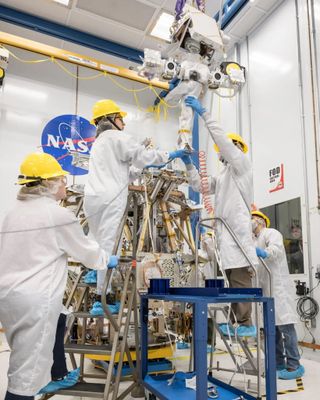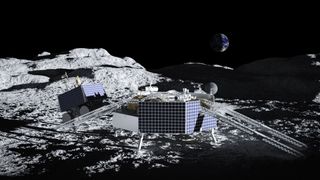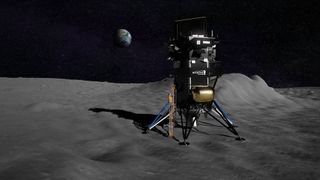It’s a classic one-minute wait on the Moon moment.
The message of NASA Last week: “NASA ends VIPER project, continues Moon exploration.”
The US space agency’s Volatiles Investigating Polar Exploration Rover (VIPER) project has undergone an extensive internal review. NASA found that the listed price was high, the launch date was delayed and costs could increase in the future, justifying the suspension of the mission.
Some disassembly is required
At this stage timeNASA invested $450 million in VIPER.
NASA said it plans to disassemble and reuse VIPER’s instruments and components for future lunar missions.
Prior to disassembly, NASA is open to expressions of interest from U.S. industry and international partners to use the existing VIPER rover system at no cost to the government.
The VIPER project will see an “orderly closure through spring 2025,” NASA said.
Related: NASA cancels $450 million VIPER lunar rover project due to budget concerns

Dead meat, dead weight
As part of NASA’s Commercial Lunar Payload Services (CLPS) public-private partnership, VIPER was intended to Earth departure via a Astrobotics Griffin lunar lander.
But Astrobotic is trying to overcome its own problems that have pushed back Griffin’s flight preparations to September 2025.
The landing without VIPER on board “will allow for a flight demonstration of the Griffin lander and its engines,” NASA said. In the absence of VIPER, a “mass simulator” will be used to simulate the weight of NASA’s missing rover.
A rough start for a smooth ride

To begin with, it hasn’t all been plain sailing for Astrobotic.
In January of this year, the Astrobotic Peregrine Mission One mission to the moon failed due to a propulsion problem in space.
An investigation into the reasons for the failure of the private company’s first lunar lander is underway, Astrobotic said.
“Continuing the VIPER program would result in increased costs that would threaten to cancel or disrupt other CLPS missions,” the space agency’s statement said. “NASA has informed Congress of the agency’s intent.”

Nicola Fox, deputy administrator for the Science Mission Directorate at NASA Headquarters in Washington, added in a statement:
“The agency has planned a series of missions to search for ice and other resources on the Moon over the next five years.”
Cede leadership
“VIPER is 100 percent built and has completed some of its testing. It’s ready to go and NASA is giving up a very capable rover and ceding its leadership in resource exploration,” said Clive Neal, a leading lunar scientist at the University of Notre Dame in Indiana.
“This is a dark day for lunar science and exploration and perhaps the Artemis Program“Neal told Space.com. “I’m still in shock at the reasoning used to justify the cancellation of VIPER.”
Norbert Schörghofer, a senior scientist at the Institute for Planetary Science, focuses his research on the study of water ice in the polar regions of the Moon.

Schörghofer considers identifying the abundance and distribution of water ice in the lunar polar regions to be “a scientific and exploration priority.”
“The cancellation of VIPER is a major loss for science,” Schörghofer told Space.com. “No other U.S. robotic mission to the Moon in the next three years has the capabilities needed. You need mobility and a way to explore the subsurface, not just the surface.”
Fundamental Truth
The hunt for ground truth for lunar water ice, Schörghofer added, will likely be carried out by Japan’s Lunar Polar Exploration Project (LUPEX), currently underway with India and scheduled to launch in 2025. Observational equipment from NASA and the European Space Agency (ESA) will also be installed on the LUPEX rover.
Or perhaps the necessary detective work on lunar water ice, Schörghofer said, could be done by China’s robotic lander, Chang’e-7, in 2026.
“A manned mission to the South Pole region could achieve the goal, but who can say whether it will fly as planned,” Schörghofer said.
“If we really want to find ice on the Moon, we also need a mission that can explore large, permanently cold and dark craters, which even VIPER and Artemis 3 (with NASA crew) will not be able to reach. And that seems even further into the future,” Schörghofer said.
Devastating news

The planned end of the VIPER program is devastating news, said Benjamin Greenhagen, president of the Lunar Exploration Analysis Group (LEAG).
Since 2004, LEAG has helped NASA analyze scientific, technical, commercial and operational issues in support of lunar exploration goals.
“The LEAG community has long supported VIPER and Resource Prospector before it,” Greenhagen told his lunar exploration colleagues via the Lunar-L community publication website. “We believe in this mission and the unique value it brings to lunar exploration that will be lost if VIPER does not fly.”
Uncertain situation
Beyond the hardware, Greenhagen said, “VIPER is about people and there should be significant concern for the engineers and scientists working to test and fly the completed rover given the uncertain situation. Please keep the VIPER team in mind.”
Greenhagen said, “LEAG will be working to bring this message to NASA in the coming weeks, and I expect there will be other organized individual and community efforts as well.”
Such action has already begun.
In light of NASA’s announcement of its decision to cancel the VIPER mission, space Scientists have drafted a dotted-line letter of support that will be sent to members of the US Congress, urging them to reconsider their decision.
Opposition to NASA Closure
In an open letter to Congress, the statement calls on lawmakers to reject NASA’s cancellation of the VIPER lunar mission.
The open letter has already garnered over 140 signatures from over 24 states in the US. Plans are underway to directly contact the House and Senate committees affected by the letter, asking them to oppose NASA’s elimination of the VIPER program.
“We are deeply concerned by NASA’s shocking announcement on July 17 that it intends to terminate the VIPER lunar rover mission,” the letter states. “VIPER was intended to be a groundbreaking American project and NASA’s first mission to characterize the origin and distribution of water ice on and beneath the surface of the Moon, a key step toward enabling human exploration…”
Unprecedented, indefensible
The open letter points out that the decision to cancel the mission “was made by NASA without providing the VIPER team or the lunar exploration community with an opportunity to propose cost-saving solutions or alternatives to dismemberment or disposal of the rover.”
The VIPER rover is already fully built, the letter notes, and was scheduled to undergo final testing in the coming months before its launch in 2024-2025.
“The decision to cancel the project at this point, after spending $450 million,” the letter argues, “is both unprecedented and indefensible.”